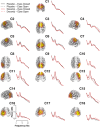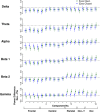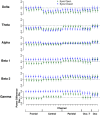The effects of dexamphetamine on the resting-state electroencephalogram and functional connectivity
- PMID: 26577247
- PMCID: PMC6867410
- DOI: 10.1002/hbm.23052
The effects of dexamphetamine on the resting-state electroencephalogram and functional connectivity
Abstract
The catecholamines-dopamine and noradrenaline-play important roles in directing and guiding behavior. Disorders of these systems, particularly within the dopamine system, are associated with several severe and chronically disabling psychiatric and neurological disorders. We used the recently published group independent components analysis (ICA) procedure outlined by Chen et al. (2013) to present the first pharmaco-EEG ICA analysis of the resting-state EEG in healthy participants administered 0.45 mg/kg dexamphetamine. Twenty-eight healthy participants between 18 and 41 were recruited. Bayesian nested-domain models that explicitly account for spatial and functional relationships were used to contrast placebo and dexamphetamine on component spectral power and several connectivity metrics. Dexamphetamine led to reductions across delta, theta, and alpha spectral power bands that were predominantly localized to Frontal and Central regions. Beta 1 and beta 2 power were reduced by dexamphetamine at Frontal ICs, while beta 2 and gamma power was enhanced by dexamphetamine in posterior regions, including the parietal, occipital-temporal, and occipital regions. Power-power coupling under dexamphetamine was similar for both states, resembling the eyes open condition under placebo. However, orthogonalized measures of power coupling and phase coupling did not show the same effect of dexamphetamine as power-power coupling. We discuss the alterations of low- and high-frequency EEG power in response to dexamphetamine within the context of disorders of dopamine regulation, in particular schizophrenia, as well as in the context of a recently hypothesized association between low-frequency power and aspects of anhedonia. Hum Brain Mapp 37:570-588, 2016. © 2015 Wiley Periodicals, Inc.
Keywords: ADHD; Bayesian; Parkinson's; anhedonia; dopamine; noradrenaline; orthogonalized connectivity; psychosis; schizophrenia.
© 2015 Wiley Periodicals, Inc.
Figures







References
-
- Abi‐Dargham A, van de Giessen E, Slifstein M, Kegeles LS, Laruelle M (2009): Baseline and amphetamine‐stimulated dopamine activity are related in drug‐naïve schizophrenic subjects. Biol Psychiatry 65:1091–1093. - PubMed
-
- Albrecht MA, Martin‐Iverson MT, Price G, Lee J, Iyyalol R (2011a): Dexamphetamine‐induced reduction of P3a and P3b in healthy participants. J Psychopharmacol (Oxf) 25:1623–1631. - PubMed
-
- Albrecht MA, Martin‐Iverson MT, Price G, Lee J, Iyyalol R, Waters F (2011b): Dexamphetamine effects on separate constructs in the rubber hand illusion test. Psychopharmacology (Berl) 217:39–50. - PubMed
-
- Albrecht MA, Price G, Lee J, Iyyalol R, Martin‐Iverson MT (2012): Dexamphetamine reduces auditory P3 delta power and phase‐locking while increasing gamma power. Eur Neuropsychopharmacol 22:734–746. - PubMed
Publication types
MeSH terms
Substances
LinkOut - more resources
Full Text Sources
Other Literature Sources
Miscellaneous

